I mazzi di piscina che si spezzano, trattengono il calore e diventano pericolosamente scivolosi quando bagnati sono le migliori preoccupazioni per i proprietari di piscina. Il cemento tradizionale e le pavimentazioni non sono spesso all'altezza, lasciando i proprietari di case frustrati da costi di manutenzione e pericoli per la sicurezza attorno al loro investimento.
Pietra sciolta I mazzi di piscina offrono un'alternativa avvincente che affronta questi problemi frontalmente. Con capacità di drenaggio superiori, fascino estetico naturale e costi di installazione significativamente più bassi, la pietra sciolta sta guadagnando popolarità tra i costruttori di piscina e i proprietari di case in cerca di dintorni funzionali e bellissimi. Questa guida completa esplora tutto ciò che devi sapere sull'implementazione di questo Ride-o-Die Soluzione per l'area della piscina, dalla selezione dei materiali giusti per garantire stabilità e prestazioni a lungo termine.
Il fascino della pietra sciolta: benefici e versatilità del design per i mazzi di piscina
Quando stai cercando di creare una straordinaria area a bordo piscina che si distingue dai disegni di cookie-cutter, i ponti in pietra sciolti offrono un'alternativa avvincente ai materiali tradizionali. Naturale, versatile e funzionale, queste superfici distintive portano un tocco di eleganza organica che il calcestruzzo semplicemente non può eguagliare.
I mazzi di piscina in pietra sciolti offrono un drenaggio superiore, un'estetica naturale ed efficacia in termini di costi rispetto ai materiali di decking della piscina convenzionali, pur richiedendo una manutenzione minima per i proprietari di case in cerca di valore a lungo termine.
Estetica naturale: migliorare il fascino visivo della tua piscina
C'è qualcosa di intrinsecamente attraente nel fascino rustico della pietra sciolta che circonda una piscina. A differenza dell'aspetto uniforme del cemento, ogni pietra porta il proprio carattere nello spazio esterno. Le varie trame, colori e forme creano a “strabiliante mascella” Impatto visivo che trasforma un normale pool in un'oasi naturale.
Se correttamente installato, un allentato PECCHE POLCA STONE si integra perfettamente con il paesaggio circostante, creando un ambiente esterno coeso che sembra intenzionalmente progettato piuttosto che costruito artificialmente. IL Variazioni naturali nella pietra La colorazione aiuta anche a mascherare le macchie d'acqua e gli agenti atmosferici che sarebbero immediatamente visibili su superfici in cemento.
Drenaggio superiore: sicurezza e benefici pratici
One of the most significant advantages of loose stone as pool deck material is its exceptional drainage capability. Water passes freely between stones, eliminating the puddles and standing water common with solid surfaces. This natural drainage system significantly reduces slip hazards around your pool area.
The porous nature of loose stone installations also helps manage rainwater runoff, directing it back into the ground rather than overwhelming drainage systems. This environmental benefit combines practical safety with responsible water management for your property.
Cost-Effectiveness: Initial Investment vs. Long-Term Value
While initial installation costs vary depending on stone selection, loose stone pool decks generally require a smaller upfront investment than pavers or poured concrete. The table below compares key financial and practical factors across popular pool decking options:
Pool Deck Material Comparison (2023 Market Analysis)
| Fattore | Pietra sciolta | Concrete | Finitrici | Decking composito | Natural Stone Tiles |
|---|---|---|---|---|---|
| Initial Cost (per sq.ft) | $5-$10 | $7-$15 | $10-$20 | $15-$30 | $18-$35 |
| Complessità di installazione | Moderare | Alto | Alto | Moderare | Molto alto |
| Durata della vita (anni) | 15-20 | 10-15 | 15-25 | 10-15 | 20-30 |
| Annual Maintenance Cost | $0.30/sq.ft | $0.50/sq.ft | $0.45/sq.ft | $0.60/sq.ft | $0.75/sq.ft |
| Ritenzione del calore | Basso | Molto alto | Alto | Moderare | Moderate-High |
The relative ease of repairs represents another cost advantage. If damage occurs to a specific area, you can simply replace the affected stones rather than dealing with extensive concrete repairs or paver realignment.
Eco-Friendly Aspects: Sustainable Pool Design
For environmentally conscious homeowners, loose stone offers significant advantages over manufactured materials. As a natural product, stone requires minimal processing compared to concrete or composite materials, resulting in a substantially smaller carbon footprint.
I benefici di Pietra sciolta around pools extend beyond manufacturing considerations. The permeability of stone installations allows water to filter naturally into the soil, reducing runoff and supporting healthy groundwater systems. This permeable quality can even help meet local regulations for impervious surface limitations in some areas.
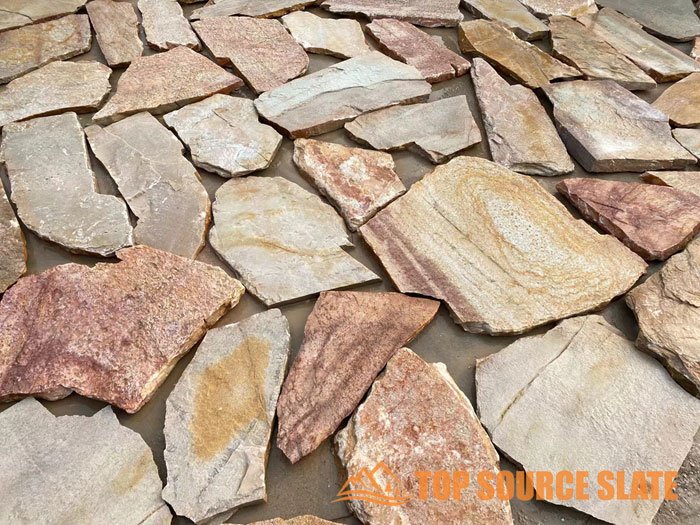

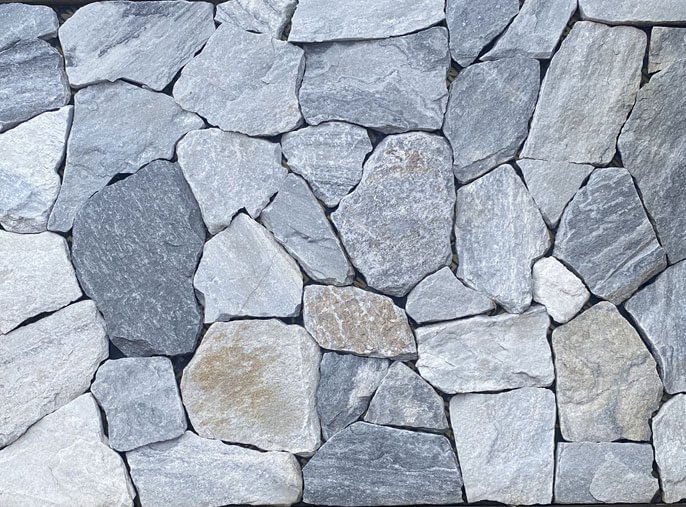
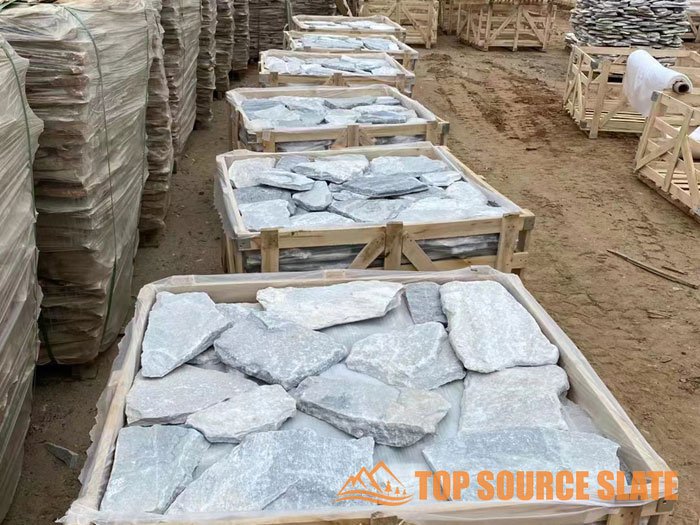
Top Source Slate’s loose stone options showcase exceptional variety in colors and textures, allowing for truly customized pool environments that reflect your personal style. From warm earth tones to cool blue-grays, their Pietra naturale selections provide design flexibility while maintaining the practical benefits of loose stone pool decks.
Installation Essentials: A Step-by-Step Guide to a Stable and Stunning Loose Stone Pool Deck
Installing a loose stone pool deck can transform your outdoor space with natural beauty while providing practical benefits like improved drainage and comfort underfoot. However, proper installation is crucial for ensuring longevity and safety. This comprehensive guide walks you through the essential steps to create a durable, attractive loose stone pool deck that will enhance your poolside experience for years to come.
A properly installed loose stone pool deck requires thorough ground preparation, appropriate edging solutions, careful stone selection, and proper installation techniques to ensure stability, drainage, and aesthetic appeal around your pool area.
Ground Preparation: Building a Solid Foundation
The success of your loose stone pool deck begins well before the first stone is placed. Start by thoroughly removing all vegetation, organic matter, and topsoil from the installation area. This prevents future settling and organic growth that could destabilize your deck.
Next, create a slight slope (around 1/4 inch per foot) away from your pool to encourage proper drainage. Compact the soil using a plate compactor to create a solid base, then add a 4-6 inch layer of crushed gravel or limestone as your sub-base. This layer should also be thoroughly compacted to prevent future shifting.
Finally, add a 1-2 inch layer of coarse sand as your setting bed. Level this carefully, as it will directly impact how even your finished loose stone pool deck appears. Taking time during this preparation phase significantly reduces maintenance headaches later.
Edging Solutions: Containing Your Design
Effective edging is crucial for maintaining the integrity of your loose stone pool deck. Without proper containment, stones will gradually migrate outward, creating an uneven and potentially hazardous surface. Several edging options offer both functional and aesthetic benefits:
Pool Deck Edging Comparison by Material and Application
| Edging Type | Materiale | Difficoltà di installazione | Durabilità | Cost Range (per linear ft) | Best Application |
|---|---|---|---|---|---|
| Metal Landscape Edging | Aluminum/Steel | Moderare | 7-15 years | $4-$10 | Curved designs, clean modern look |
| Plastic/Composite Edging | HDPE/Recycled Materials | Facile | 5-10 anni | $2-$5 | Budget installations, easy DIY |
| Pietra naturale Borders | Granite/Limestone | Difficile | 20+ anni | $15-$30 | High-end installations, natural aesthetic |
| Concrete Curbing | Poured Concrete | Very Difficult | 15-20 anni | $10-$25 | Maximum stability, professional installation |
| Timber Edging | Cedar/Pressure-Treated | Moderare | 5-7 anni | $6-$12 | Rustic designs, raised sections |
For a “Solido di roccia” installation, install your chosen edging before laying stones. Secure it firmly according to manufacturer specifications, ensuring it extends at least 1-2 inches above your finished stone surface for effective containment.
Stone Selection: Choosing the Right Materials
The type of stone you select dramatically impacts both the appearance and functionality of your loose stone pool deck. Consider these critical factors when making your selection:
Size consistency matters significantly for stability – stones between 3/8″ and 3/4″ offer an ideal balance between comfort underfoot and drainage capability. Angular stones interlock better than rounded ones, creating a more stable surface. For maximum comfort, avoid extremely small stones that can become uncomfortable underfoot or larger stones that create an uneven walking surface.
Consider both the climate and your pool’s design when selecting stone colors. Lighter stones reflect heat in sunny environments but show debris more visibly. Top Source Slate offers factory-direct stone options with consistent sizing and quality, ensuring your pool deck maintains its beauty through years of use.
Installation Techniques: Bringing It All Together
With proper preparation complete, spread your chosen stones evenly across the prepared area at a depth of 2-3 inches. Use a landscape rake to distribute them uniformly, then lightly spray the surface with water to help settle the stones.
For enhanced stability, consider using a plate compactor with a rubber mat attachment to gently compress the stones. This significantly reduces future settlement without damaging the stone. Finally, top off any low areas with additional stone and repeat the settling process as needed.

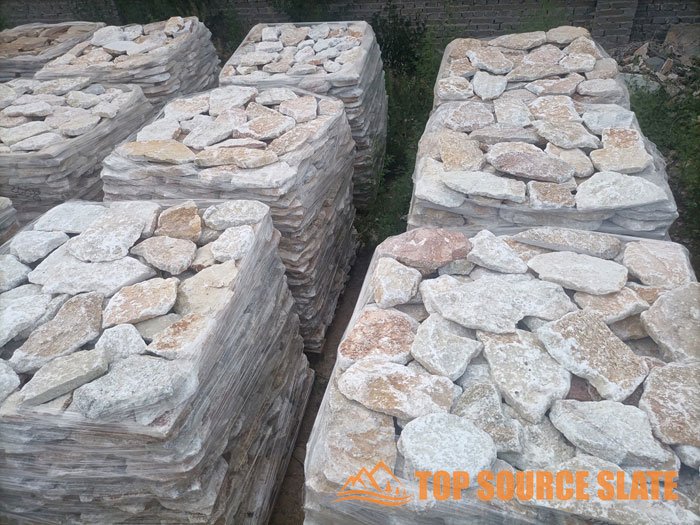
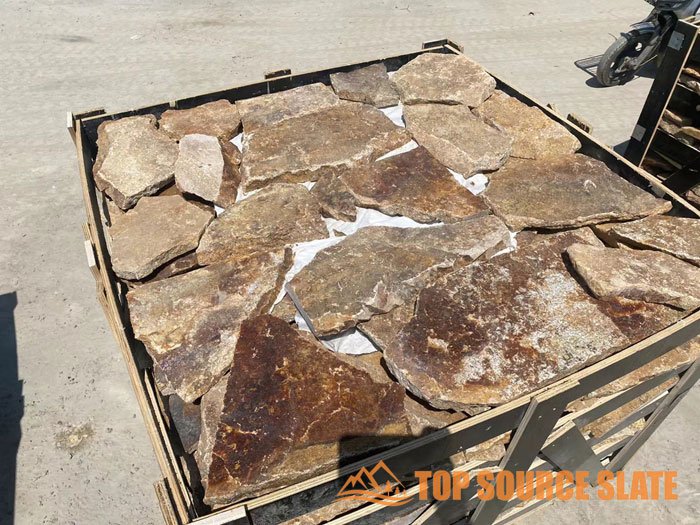
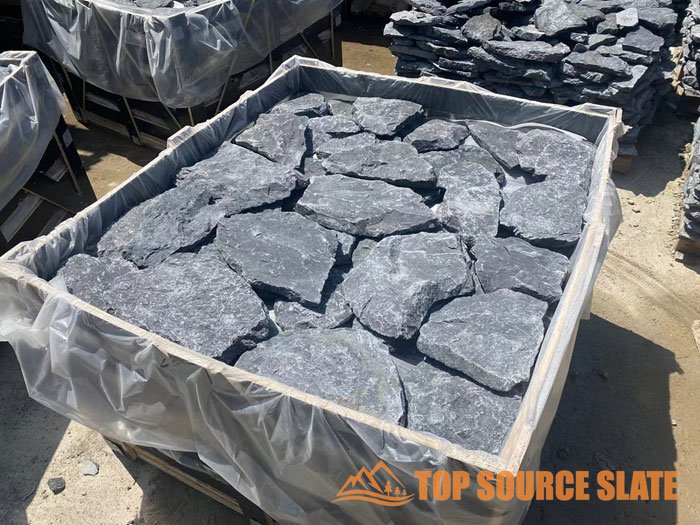
Maintenance and Stone Selection: Ensuring Longevity and Beauty for Your Loose Stone Pool Deck
A beautiful loose stone pool deck requires thoughtful maintenance and informed stone selection to preserve its natural appeal and functionality. With proper care and the right materials, your pool surround can remain an inviting outdoor feature for many years, offering both aesthetic charm and practical benefits.
Regular maintenance combined with strategic stone selection are key factors in maximizing the lifespan and appearance of loose stone pool decks, with proper material choices significantly impacting both long-term durability and maintenance requirements.
Routine Maintenance: Simple Steps for Lasting Beauty
Maintaining a loose stone pool deck doesn’t demand complex procedures, but consistency is crucial. Start with regular raking to keep the surface level and evenly distributed, especially after heavy rain or high pool usage. This simple practice prevents low spots where water might collect and helps maintain a uniform appearance.
Periodic cleaning with a gentle rinse from a garden hose removes dirt, debris, and any pool chemicals that may have splashed onto the stones. For more thorough cleaning, a mixture of water and mild dish soap applied with a soft-bristle brush can remove stubborn stains without damaging the stone. Avoid pressure washing, which can displace your carefully laid stones.
Plan to replenish your stone every 2-3 years to maintain proper depth and appearance. This refreshes the look of your pool area while ensuring adequate drainage and stability. Top Source Slate offers color-matched stone options that integrate seamlessly with your existing installation, maintaining a cohesive appearance.
Preventing Weed Growth: Maintaining a Pristine Appearance
Weeds can quickly diminish the appeal of your “top-notch” loose stone pool deck. The most effective prevention method begins during installation with a quality landscape fabric beneath your stone layer. This creates a physical barrier that significantly reduces weed penetration while still allowing for proper drainage.
For existing installations, consider applying an environmentally friendly pre-emergent herbicide specifically formulated for use near water features. These products prevent weed seeds from germinating without introducing harmful chemicals to your pool environment. Always follow manufacturer guidelines and local regulations for application near water sources.
Stone Durability Factors by Type and Regional Climate
| Tipo di pietra | Resistenza al calore | Freeze/Thaw Durability | Chemical Resistance | Color Stability | Best Climate Region |
|---|---|---|---|---|---|
| Limestone Pebbles | Bene | Moderare | Povero | Alto | Temperate, Dry |
| Granite Chips | Eccellente | Eccellente | Eccellente | Molto alto | All Climates |
| Marble Fragments | Moderare | Povero | Very Poor | Moderare | Mild, Dry |
| Slate Chips | Molto bene | Bene | Bene | Alto | Most Climates |
| Quartzite Gravel | Eccellente | Molto bene | Molto bene | Molto alto | All Climates |
Stone Durability: Environmental Factors
The longevity of your loose stone pool deck depends significantly on choosing materials suited to your specific environmental conditions. Stones with high density and low porosity typically offer superior resistance to pool chemicals, UV exposure, and freeze-thaw cycles in colder climates.
Consider how the stone will perform under your typical weather patterns. In regions with frequent temperature fluctuations, select stones with proven freeze-thaw stability to prevent cracking and deterioration. For hot, sunny climates, lighter-colored stones not only stay cooler underfoot but also resist UV fading better than darker alternatives.
Choosing the Right Stone: Making Informed Selections
When selecting stones for your pool deck, balance aesthetic preferences with practical considerations. Angular stones provide better stability and stay in place better than rounded pebbles, particularly important for high-traffic areas. Size consistency is equally important – choose stones between 3/8″ and 3/4″ for the optimal balance between comfort and stability.
Color selection affects more than just appearance. Lighter stones reflect heat, making them more comfortable for barefoot walking in sunny locations, while darker stones can retain heat and extend evening swim time in cooler climates. Top Source Slate’s natural stone collection offers options specifically tested for pool environments, ensuring both beauty and performance.
For a personalized consultation on the best stone options for your specific pool deck requirements, contact our stone specialists directly. Our team can recommend the ideal materials based on your climate, usage patterns, and design preferences to create a loose stone pool deck that remains beautiful with minimal maintenance for years to come.

Conclusione
After spending years in the stone industry, I’ve seen firsthand how the right materials can transform a pool area. Pietra sciolta isn’t just about aesthetics; it’s about creating a safe, functional, and beautiful space where memories are made.
Dalla mia esperienza in ardesia di alto livello, ciò che distingue un mazzo da piscina è la sua capacità di fondersi perfettamente con l'ambiente circostante offrendo benefici pratici come drenaggio superiore e resistenza al calore. Ecco perché scegliere la pietra giusta e garantire una corretta installazione è la chiave.
Ultimately, investing in a loose stone pool deck is an investment in your lifestyle. With the right approach, it’s a no-brainer way to enhance your outdoor living experience and enjoy your pool to the fullest.


